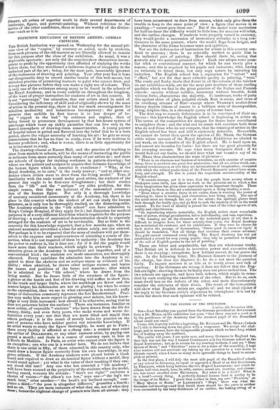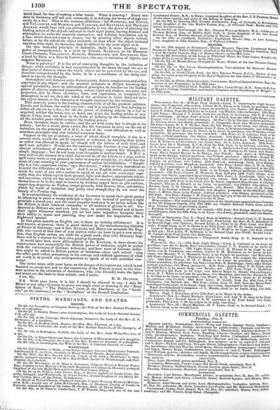TO TUE EDITOR OF THE SPECTATOR.
Londou, 8th November 1842.
Sts—Last Saturday you quoted from the German periodical on Art a remark from a Dr. MERE, on the exhibition last year, " that there was not a work in It by the gentlemen of the Academy that the meanest pupil of the Dusseldorf school could not excel." Come, this is pretty well for a beginning, Dr. Ku° LER and Dr. MERE; (whole he ?) this is throwing down the glove with a vengeance. We accept the chal- lenge, and in answer, have the inexpressible pleasure which we have long wished for, of hurling away the scabbard. The public will grant, I am quite sure, and many Germans in England too,, that this was not the way 1 treated Commies and the German school at the Royal Institution ; but, as in return for my courtesy to them, I and my " Mary Queen of Scots" and " Poictiers " come in for a share of the scurrility, I hope your readers will not attribute my taking up the question to a vain desire to obtrude myself, when I have so many more agreeable things in band to mom- plish at present. In the first place, I will defy the most able pupil of the Dusseldorf ached,. or any school in Germany, to equal or approach a Head of an Old Gentleman,. by PHILLIPS, which hung between the two Dogs of LANDSEER; and which far colour, half-tint, touch, tone, breadth, nature, sound art, drawing, and charac- ter, was never excelled since REYNOLDS. But what is in a head 1 What Is in a head!—every thing. A perfectly-formed human head is worthy to be. the image of its Maker. I grant that neither in that, my own " Poictiers," OP "Mary Queen of Scots," or LANDSEER'S "Dogs," there was what the Germans call drawing—and God forbid there should be : the parts in neither were connected by the baby-feebleness of an outline, the leading-string of ir timid hand, for fear of making a false touch. What is drawing ? Every stu- dent in Germany will tell you, commonly, it is defining the forms of things cor- rectly by a line. This is the common definition ; but RAPHAEL, and TITIAN, and VELASQUEZ, and M oair.r.o, and VANDYKE, and REYNOLDS, and MICHAEL ANGELO, would have told you philosophically, it was the power of planting the leading points of the objects imitated in their right places, leaving distance and atmosphere to unite the masterly abstraction, and defining boundaries not by a line, which does not exist in nature, but by planting other objects behind, before, or by the aide of the object imitated ; so that where the object imitated vanishes from sight, its boundary may be defined by the next object to it. On this immortal principle of imitation, there is more drawing, more power of comprehension, in a head by TITIAN, RAPHAEL in his Hampton Court Cartoons, VELASQUEZ, RUBENS, REMBRANDT, and REYNOLDS, than a head by NESS or a Nero by CORNELIUS, who are, in imitation of objects, but superior DINNERS. What is painting ? It is the art of conveying thoughts by the imitation of things ; which imitation is best comprehended by the brain through the eye at that point of distance where the whole object can be perceived by the eye, and therefore comprehended by the brain, to be a resemblance of the thing imi- tated to convey the thought. Atmosphere and distance unite distant points, flatten roughnesses, and soften asperities in any object ; and the greatest imitators in theart, knowing this optical peculiarity, have on philosophical principles, by touches on the leading points of objects, expressed proportion, colour, light and shadow, recession and projection, and by them, character, form, and expression, so completely for atmosphere to act on, that the mind of the spectator is never deceived as to the object meant, or the character or thought expressed by the imitation.
This masterly power is the leading characteristic of all the greatest painters, Greeks and Italians, the world ever saw ; and it is acquired by first learning to define all objects by a line; for till the power of defining objects by a line be acquired, neither the brain, eye, or hand, can plant the leading points of any object, if they have not been in the habit of defining by the closest imitation all the detailed parts which connect the leading points. Boys, therefore, begin by outline; and the art with every boy is always in its infancy ; but for a whole great nation like the Germans to carry on the art of imitation, on the principle of A B C, is one of the most ridiculous as well as mistaken principles that ever infected a human fancy. Suppose in the art of oratory, a man of talent should complain it was in a corrupt state, would the art be improved or reformed by insisting that before an orator was allowed to speak, he should tell the letters of each word, and spell each syllable ? Would not the audience reply, Correct, if you please, all corrupt redundancy of metaphor or high colouring; express fine thoughts in simple language ; but do not bury your thoughts in useless detail. A B C is very well in the nursery to a child, but to tell us all the letters as a man, and to spell every word as you proceed in order to acquire simplicity, we shall lose the sense of your meaning in your copiousness of useless individualities. " Simpli- city is a very suspicious virtue," says REYNOLDS, " when so very inartificial as to avoid the difficulties of the art." And I, as an English artist, question very much the right of any other nation to speak of our art with contempt, espe- cially that one which rejects back-ground, light and shadow, appropriate colour, and execution, which are the means of imitation to convey thought, and believe themselves to be in the road to heaven by sticking copper faces on gilt surfaces, carpet-beg draperies on Turkey carpet grounds, with flowers, lilies, and daisies, which for truth of imitation may justly rival though they do not excel the beauty of a Persian rug. It is extraordinary the tendency of the Germans to spend their great genius in labouring to prove a wrong principle a right one, instead of proving a right principle a sound one ; and the most singular weakness in an heroic nation like the British, is their inherent cowardice in all matters of genius in art. Un- daunted as Britons are, and ever have been, in asserting abroad and at home their rights whenever attacked, yet let but some impudent foreigner deny their ability in music and painting, they cow under the imputation like a frightened spaniel. In this gross assault on English art, is there no lurking selfishness ? It is well known, at present, there is great distress in the manufacturing districts of Fresco in Germany; and if Drs. KUGLER and MERZ can persuade the Eng- lish, who travel at this time of year sixteen miles an hour to get a new sensa- tion, that English artists are unfit for a great work, they (the Doctors) hope there will be a chance for their own gasping decorators. It would have been more philosophical in Dr. KUGLER, to have shown his countrymen, how successfully the British power of imitation might be united with the correctness of German definition, and how more of German defini- tion might be added to British powers of imitation-thus each school roing the other good-than presuming, in his corrupt and childish ignorance of what art really is, to permit any correspondent to speak of us with mortified con- tempt.
One letter more, with your leave, on the danger of decorative art, which is not founded on sound art; and on the superiority of the French system to the Ger- man system in the education of decorators, who (the French) make the figure and sound art the basis in their school; and 1 retire.
P.S. With your leave, it is fair I should be allowed to say, I defy Dr MERZ or any other German to prove one single error in drawing in the "Mary Queen of Scots," "The Poictiers," (now at the Pantheon, or the "Laza- rus," on the staircase,) or the "Xenophon," at the Russell Institution.



























 Previous page
Previous page